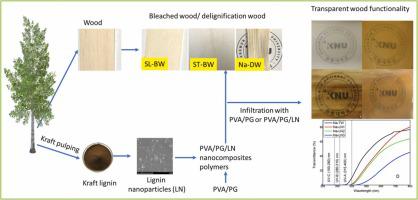Industrial Crops and Products ( IF 5.9 ) Pub Date : 2023-05-26 , DOI: 10.1016/j.indcrop.2023.116918 Le Van Hai , Seung-Woo Cho , Gu-Joong Kwon , Da-Young Lee , Seo-Young Ma , Rajkumar Bandi , Jeong-Ki Kim , Song-Yi Han , Ramakrishna Dadigala , Seung-Hwan Lee

|
Recently, transparent wood (TW) has been considered for many applications, such as windows, energy storage, and electronic devices. This study presents the fabrication of eco-friendly TW using waste lignin as a resource to enhance the TW’s performance by providing UV-shielding functionality. Three different pretreatment methods were explored for TW fabrication, including solar-assisted bleaching, steam bleaching, and NaOH delignification. The average size of the lignin nanoparticles (LNs) characterized using a scanning electron microscope and nanoparticle analyzer and was found to be around 100 nm. The LNs had zeta potentials of − 44.2 mV to − 34.9 mV for the first and sixth months, respectively. The transmittance of TW ranged from 20% to 80%, depending on the pretreatment and additional LNs content. By incorporating just 1% of LN, the TW composites were found to effectively block all UV-C, UV-B, and UV-A radiation while maintaining adequate visible light transmittance. The thermal stability, crystallinity index, and mechanical properties of wood and TW were investigated and compared. The NaOH delignification TW (Na-TW) has shown the highest transmittance, tensile strength, UV-shielding functionality, and comparable thermal stability with solar transparent wood (SL-TW) and steam transparent wood (ST-TW) methods. These findings indicate that TW LNs nanocomposite is a promising candidate for UV-shielding window applications.
中文翻译:

制造具有紫外线屏蔽功能的环保透明木材
最近,透明木材 (TW) 已被考虑用于许多应用,例如窗户、储能和电子设备。本研究介绍了使用废弃木质素作为资源来制造环保 TW,通过提供紫外线屏蔽功能来提高 TW 的性能。为 TW 制造探索了三种不同的预处理方法,包括太阳能辅助漂白、蒸汽漂白和 NaOH 脱木素。使用扫描电子显微镜和纳米粒子分析仪表征的木质素纳米粒子 (LN) 的平均尺寸约为 100 nm。在第一个月和第六个月,LN 的 zeta 电位分别为 − 44.2 mV 至 − 34.9 mV。TW 的透射率在 20% 到 80% 之间,具体取决于预处理和额外的 LNs 含量。通过仅加入 1% 的 LN,TW 复合材料被发现可以有效阻挡所有 UV-C、UV-B 和 UV-A 辐射,同时保持足够的可见光透射率。研究并比较了木材和 TW 的热稳定性、结晶度指数和机械性能。NaOH 脱木素 TW (Na-TW) 显示出最高的透光率、拉伸强度、紫外线屏蔽功能以及与太阳能透明木材 (SL-TW) 和蒸汽透明木材 (ST-TW) 方法相当的热稳定性。这些发现表明 TW LNs 纳米复合材料是紫外线屏蔽窗应用的有前途的候选者。NaOH 脱木素 TW (Na-TW) 显示出最高的透光率、拉伸强度、紫外线屏蔽功能以及与太阳能透明木材 (SL-TW) 和蒸汽透明木材 (ST-TW) 方法相当的热稳定性。这些发现表明 TW LNs 纳米复合材料是紫外线屏蔽窗应用的有前途的候选者。NaOH 脱木素 TW (Na-TW) 显示出最高的透光率、拉伸强度、紫外线屏蔽功能以及与太阳能透明木材 (SL-TW) 和蒸汽透明木材 (ST-TW) 方法相当的热稳定性。这些发现表明 TW LNs 纳米复合材料是紫外线屏蔽窗应用的有前途的候选者。



























 京公网安备 11010802027423号
京公网安备 11010802027423号